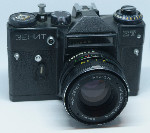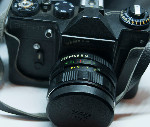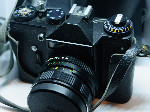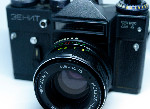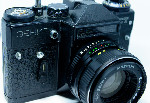The Zenit ET is an updated version of the Zenit E the camera with which I learned photography, but this post is also about the lens, the Helios 44.
Stock lens
Zenit ET
Camera: £13.31
Postage: £16.63
Lens: included
Total: £29.94
I got both camera and lens as a set, which is often how they came originally. It was the second camera I bought in my collection and came all the way from Kiev via Etsy. If I’m honest the lens was the main reason I went for this camera, but it certainly helped that it was attached to a camera similar to the one with which I’d learned photography.
Manual mode only
The Zenit ET has the usual manual shutter speed controls, whereas the aperture and focus is set on the lens. It has a built-in light meter, but the selenium cell in my example is long dead, so it doesn’t work. It would function just like a light meter, which I needed to use instead. You set the film speed and match the dial with the light sensed when pointing it at the scene. You then dial those settings into the camera yourself – there was nothing automatic even when it was working.
Split design
The main thing that makes cameras like the Zenit ET different from a point and shoot camera is that you can change the lenses to suit your requirement. The shutter is closed on the camera body so it is perfectly safe to change lenses part-way through a film if you want to. With one camera you can use the perfect portrait lens, a wide-angle landscape lens or a telephoto zoom lens.
I haven’t really talked about lenses before but they are basically the eye of the camera. Having a camera where you can change them helps you to quickly learn about the differences, but for this post I’ll concentrate on the Helios 44.
All about the bokeh
The Helios 44 is a general-purpose prime lens with a focal length of 58mm and maximum aperture of f/2. Prime just means it’s not a zoom lens. A 58mm focal length means it is slightly zoomed-in, 50mm is about the same magnification as your eye. The aperture of f/2 just means it opens quite wide – it can let a lot of light in – which can make it useful in lower light conditions.
Often called a copy of the Carl Zeiss Biotar lens it is considered a very nice portrait lens. When open wide and focussed on a close subject can produce a pleasing swirling blur or hexangonal light points in the background, known as a nice bokeh effect.
The pics
Ilford FP4
Cost: £0.99
Postage: £2.90
ISO: 125
Format/Type: BW Negative
Exposures: 36
Processing: £3.99
Full Total: £8.68
Cost per shot: £0.24
My Rating: 8
Fortunately the Zenit ET helped me out by producing some great images, some strikingly contrasted some soft and balanced.
However the camera did deliver a nasty surprise at the end by breaking off the end of the film when winding on. To save the film I had to open the film canister in the dark and wind the film back in which did a bit of visible damage to the last few frames.

